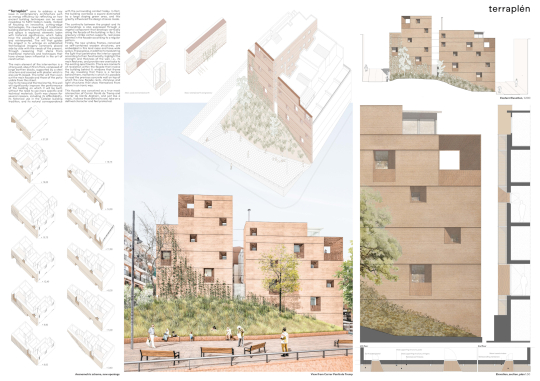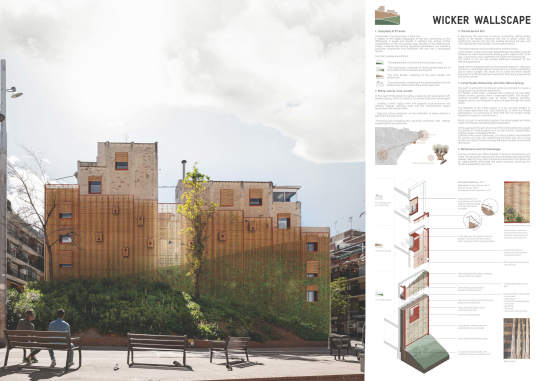Pantà de Tremp
Winners

Terraplén
The jury affirms that this proposal is very different from the others due to the chosen finishing material, which are earthen blocks. The solution presented, with a wall 70 cm thick, fits very well in this blind wall, with the embankment in front of it at the bottom, which gives the project its name and which allows the greenery to climb into it. In addition, they would like to highlight the flexibility to create windows while maintaining the original design.

WICKER WALLSCAPE
The jury mentions the simplicity of this proposal, where the idea of renewal appears, but which at the same time is nourished by the existence and nakedness of what is currently there. The effort with regard to the sustainable view is also highlighted, as well as the ecological and circular economy footprint, not always present in the other proposals.

The view from days gone
The jury appreciates the effort of this proposal to re-wild the space, by presenting a style of greenery which has been studied in great detail, that rises through a structure that covers the almost intact blind wall, and where the final image aims to show this large green window to the city.
Information of the blind wall
| Party wall area | 460m2 (aprox.) |
| Estimated construction cost | 750 €/m2 |
The party walls at Site 7 are located opposite the public space formed by the intersection of Carrer del Pantà de Tremp, Carrer de Moratín and Carrer de Dante Alighieri in the El Carmel neighbourhood of Barcelona’s Horta-Guinardó district. El Carmel is a neighbourhood located on the northern slope of the Turó del Carmel, with steep streets, a dense urban fabric, residential character and few open public spaces, except for the Parc dels Tres Turons and La Rambla del Carmel. It is a densely urbanised area with modest residential buildings constructed in the 1960s and 1970s, the result of the significant
demographic growth that Barcelona experienced due to the migration of people from all over Spain.
The proposed site includes the party walls of two residential buildings that went up at the same time, bordering a plot that was originally building land but was instead turned into a public area to create more open space in the neighbourhood. A leisure area at a higher level than Carrer del Pantà de Tremp was created, preserving the land around the building, the trees and the existing vegetation.
The large party wall dominates this space, both because of its height and because of the slope of the streets, and it is only partially covered by the trees in front of it. It is a quiet square, as the services and shops are concentrated around Carrer de Llobregós and the metro station. Due to the slope of the northeast side of the square in relation to the street, it is not a very busy place, with the only activity coming from terrace of the bar on the ground floor of the building at Carrer de Dante Alighieri 151.



